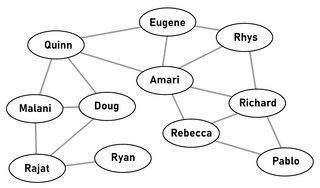
Judaism is an Abrahamic, monotheistic, and ethnic religion comprising the collective religious, cultural, and legal tradition and civilization of the Jewish people. It has its roots as an organized religion in the Middle East during the Bronze Age. Modern Judaism evolved from Yahwism, the religion of ancient Israel and Judah, by the late 6th century BCE, and is thus considered to be one of the oldest monotheistic religions. Judaism is considered by religious Jews to be the expression of the covenant that God established with the Israelites, their ancestors. It encompasses a wide body of texts, practices, theological positions, and forms of organization.

Orthodox Judaism is the collective term for the traditionalist and theologically conservative branches of contemporary Judaism. Theologically, it is chiefly defined by regarding the Torah, both Written and Oral, as revealed by God to Moses on Mount Sinai and faithfully transmitted ever since.

Haredi Judaism consists of groups within Orthodox Judaism that are characterized by their strict adherence to halakha and traditions, in opposition to modern values and practices. Its members are usually referred to as ultra-Orthodox in English; however, the term "ultra-Orthodox" is considered pejorative by many of its adherents, who prefer terms like strictly Orthodox or Haredi. Haredi Jews regard themselves as the most religiously authentic group of Jews, although other movements of Judaism disagree.
Modern Orthodox Judaism is a movement within Orthodox Judaism that attempts to synthesize Jewish values and the observance of Jewish law with the secular, modern world.

Israelis are the citizens and nationals of the State of Israel. The country's populace is composed primarily of Jews and Arabs, who respectively account for 75 percent and 20 percent of the national figure; followed by other ethnic and religious minorities, who account for 5 percent.
Jewish religious movements, sometimes called "denominations", include different groups within Judaism which have developed among Jews from ancient times. Today, the most prominent divisions are between traditionalist Orthodox movements ; modernist movements such as Conservative, Masorti and Reform Judaism; and secular or Hiloni Jews.

Religious Zionism is an ideology that combines Zionism and Orthodox Judaism. Its adherents are also referred to as Dati Leumi, and in Israel, they are most commonly known by the plural form of the first part of that term Datiim. The community is sometimes called כִּפָּה סְרוּגָה Kippah seruga, literally, "Knitted kippah", the typical head covering worn by male adherents to Religious Zionism.

African Jewish communities include:
"Who is a Jew?" is a basic question about Jewish identity and considerations of Jewish self-identification. The question pertains to ideas about Jewish personhood, which have cultural, ethnic, religious, political, genealogical, and personal dimensions. Orthodox Judaism and Conservative Judaism follow Jewish law (Halakha), deeming people to be Jewish if their mothers are Jewish or if they underwent a halakhic conversion. Reform Judaism and Reconstructionist Judaism accept both matrilineal and patrilineal descent as well as conversion. Karaite Judaism predominantly follows patrilineal descent as well as conversion.
Schisms among the Jews are cultural as well as religious. They have happened as a product of historical accident, geography, and theology.
Religion in Israel is manifested primarily in Judaism, the ethnic religion of the Jewish people. The State of Israel declares itself as a "Jewish and democratic state" and is the only country in the world with a Jewish-majority population. Other faiths in the country include Islam, Christianity and the religion of the Druze people. Religion plays a central role in national and civil life, and almost all Israeli citizens are automatically registered as members of the state's 14 official religious communities, which exercise control over several matters of personal status, especially marriage. These recognized communities are Orthodox Judaism, Islam, the Druze faith, the Roman, Armenian Catholic, Maronite, Greek Catholic, Syriac Catholic, Chaldean, Greek Orthodox, Syriac Orthodox, Armenian Apostolic and Anglican churches, and the Baháʼí Faith.

The history of the Jews in Antwerp, a major city in the modern country of Belgium, goes back at least eight hundred years. Jews were first attested in the early Middle Ages, and it may be that many of the Jews who helped establish Antwerp as a commercial hub in the Low Countries were refugees from England and France. In the early 16th century, crypto-Jews from the Iberian peninsula were attracted to the city, though they were later persecuted under Spanish rule, and many were expelled. Some returned after the Peace of Westphalia, but it was not until the French rule that Jews could live in peace in Antwerp, though in 1808 they were forced to adopt local names. The population grew when Antwerp got to be ruled by the Dutch, and even more after Belgian independence. On the eve of World War II, there were some 50,000 Jews in the city, many connected to the diamond industry, and there was a lively Jewish culture, with various organizations, sports clubs, and cultural groups, including Zionist groups. When Belgium was liberated in 1944, there were only 800 Jews left. Since then, the Jewish community of Antwerp has grown, to around 18,000 in the early 2000s.
An ethnoreligious group is a grouping of people who are unified by a common religious and ethnic background.

Hiloni, plural hilonim, is a social category in Israel, designating the least religious segment among the Jewish public. The other three subgroups on the scale of Jewish-Israeli religiosity are the masortim, "traditional"; datiim, "religious"; and haredim, "ultra-religious" ("ultra-Orthodox"). In the 2018 Israel Central Bureau of Statistics' survey, 43.2% of Jews identified as hiloni.

Australian Jews, or Jewish Australians, are Jews who are Australian citizens or permanent residents of Australia. In the 2016 census, there were 21,175 Australians who identified as Jewish by ancestry, a decrease from 25,716 in the 2011 census, and 91,016 Australians who identified as adherents of Judaism, which is a 6% decrease on 97,355 adherents of Judaism in the 2011 census. The actual number is almost certainly higher, because an answer to the religion question on the census was optional and because Holocaust survivors, Haredi Jews or many non-practising Jews are believed to prefer not to disclose religion in the census. By comparison, the Israeli newspaper Haaretz estimated a Jewish-Australian population of 120,000-150,000, while other estimates based on the death rate in the community estimate the size of the community as 250,000. Based on the census data, Jewish citizens make up about 0.4% of the Australian population. The Jewish community of Australia is composed mostly of Ashkenazi Jews, though there are Jews in Australia from many other traditions and levels of religious observance and participation in the Jewish community.

Jews or Jewish people are an ethnoreligious group and nation originating from the Israelites and Hebrews of historical Israel and Judah. Jewish ethnicity, nationhood, and religion are strongly interrelated, as Judaism is the ethnic religion of the Jewish people, although its observance varies from strict to none.
Secularism in Israel shows how matters of religion and how matters of state are related within Israel. Secularism is defined as an indifference to, rejection, or exclusion of religion and religious consideration. In Israel, this applies to the entirely secular community that identifies with no religion and the secular community within the Jewish community. When Israel was established as a new state in 1948, a new and different Jewish identity formed for the newly created Israeli population. This population was defined by the Israeli culture and Hebrew language, their experience with the Holocaust, and the need to band together against conflict with hostile neighbors in the Middle East.
Masortim is an Israeli Hebrew term for Jews who perceive and define themselves as neither strictly religious (dati) nor secular (hiloni). Their affinity is mainly to mohels and rabbis of Orthodox Judaism, and they comprise roughly one-third of the Jewish population in Israel.
The relationship between Judaism and politics is a historically complex subject, and has evolved over time concurrently with both changes within Jewish society and religious practice, and changes in the general society of places where Jewish people live. In particular, Jewish political thought can be split into four major eras: Biblical, Rabbinic, Medieval, and Modern.

Six degrees of separation is the idea that all people are six or fewer social connections away from each other. As a result, a chain of "friend of a friend" statements can be made to connect any two people in a maximum of six steps. It is also known as the six handshakes rule.










